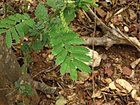Note: This is a project under development. The articles on this wiki are just being initiated and broadly incomplete. You can Help creating new pages.
Albizia amara - Krishnasirish
Albizia amara is a small to moderate-sized, much-branched deciduous tree. it can grow up to 15 metres tall. It has a smooth, dark green, scaly bark. The tree is harvested from the wild for local use as a medicine, source of wood and other materials.
Uses
Parts Used
Chemical Composition
The seed extract showed DNA binding activity, which has been found to be due to pithecolibine alkaloids, budmunchiamines. The leaves contain prodelphinidins, myricitrin, hyperin, quercitrin, transp-coumaric acid, cis-p-coumaric acid and trans-ferulic acid. The seeds contain echinocystic acid and taxifolin--O-beta-D xylopyranosyl-beta-D-arbinopyranoside. [2]
Common names
| Language | Common name |
|---|---|
| Kannada | Balukambi, Beelkambi, Chigare |
| Hindi | |
| Malayalam | Chalavagai, Oosulay, Sulivaka |
| Tamil | Arappu, Arappumaram |
| Telugu | Chigara, Chikkareni |
| Marathi | Lulai, Loullei, Thugli |
| Gujarathi | |
| Punjabi | |
| Kashmiri | |
| Sanskrit | Krishnasirish |
| English |
Properties
Reference: Dravya - Substance, Rasa - Taste, Guna - Qualities, Veerya - Potency, Vipaka - Post-digesion effect, Karma - Pharmacological activity, Prabhava - Therepeutics.
Dravya
Rasa
Guna
Veerya
Vipaka
Karma
Prabhava
Habit
Identification
Leaf
| Kind | Shape | Feature |
|---|---|---|
| Bipinnate | Alternate | Stipulate; stipules minute, free, lateral, lanceolate, cauducous; rachis 3-15 cm, slender, pulvinate, with a gland near the base on the upper side, yellow tomentose. |
Flower
| Type | Size | Color and composition | Stamen | More information |
|---|---|---|---|---|
| Bisexual | Heads solitary or 2-3 in axillary fascicles | Pale yellow | 6-8 mm long; peduncle to 5 cm, slender, densely pubescent; bracts to 5 mm, cauducous | {{{5}}} |
Fruit
| Type | Size | Mass | Appearance | Seeds | More information |
|---|---|---|---|---|---|
| Pods | 10-24 x 2.5-4 cm | Flat, greyish-brown, veiny, straight or wavy along margin, base and apex rotund, horned, indehiscent | Seeds 6-13, compressed, ovate-orbicular |
Other features
List of Ayurvedic medicine in which the herb is used
Where to get the saplings
Mode of Propagation
How to plant/cultivate
Seed - it has a hard seedcoat and may benefit from scarification before sowing to speed up germination. This can usually be done by pouring a small amount of nearly boiling water on the seeds (being careful not to cook them!) and then soaking them for 12 - 24 hours in warm water. By this time they should have imbibed moisture and swollen - if they have not, then carefully make a nick in the seedcoat (being careful not to damage the embryo) and soak for a further 12 hours before sowing. The treated seed can be then sown and will germinate within 7 - 10 days. Germination rate is about 80%. [5]
Commonly seen growing in areas
Photo Gallery
References
External Links
- Ayurvedic Herbs known to be helpful to treat Hairfall
- Ayurvedic Herbs known to be helpful to treat Dandruff
- Ayurvedic Herbs known to be helpful to treat Piles
- Ayurvedic Herbs known to be helpful to treat Diarrhea
- Ayurvedic Herbs known to be helpful to treat Gonorrhoea
- Ayurvedic Herbs known to be helpful to treat Leprosy
- Ayurvedic Herbs known to be helpful to treat Boils
- Ayurvedic Herbs known to be helpful to treat Burns
- Ayurvedic Herbs known to be helpful to treat Cough
- Ayurvedic Herbs known to be helpful to treat Malaria
- Ayurvedic Herbs known to be helpful to treat Ulcers
- Herbs with Leaves used in medicine
- Herbs with Bark used in medicine
- Herbs with Pods used in medicine
- Herbs with Seeds used in medicine
- Herbs with common name in Kannada
- Herbs with common name in Malayalam
- Herbs with common name in Tamil
- Herbs with common name in Telugu
- Herbs with common name in Marathi
- Herbs with common name in Sanskrit
- Habit - Tree
- Index of Plants which can be propagated by Seeds
- Index of Plants which can be propagated by Cuttings
- Herbs that are commonly seen in the region of Dry deciduous forest
- Herbs that are commonly seen in the region of Tropical area
- Herbs that are commonly seen in the region of Dry area
- Herbs
- Fabaceae







